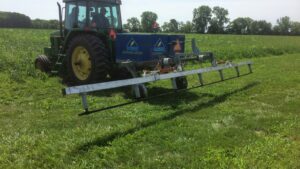To make your crop protection products more effective, it’s imperative to learn how product resistance and stewardship go together.
Stewardship means many things to different people, but managing crop protection products well is one critical component.
“Not only are we managing the product in the market, but we also have to protect the environment and the users of that product,” says Ray McAllister, senior director, regulatory policy, CropLife America.
Kevin W. Langdon, product biology lead at Syngenta, North America, says the more we think about resistance, the longer a pesticide can be used.
“Resistance management begins
well before a product is ever registered
because resistance can cause the product
lifecycle to be cut short as a viable option
within a cropping system,” Langdon says.
“Managing the use of a product can help
extend the life of that product.”
Understanding the Cause
To better understand resistance, getting to the root of the issue is key.
“Natural mutations occur in any population,” says Duane A. Martin, commercial traits manager, Syngenta. “Even without ever applying any active ingredient, we will see those natural genetic mutations.”
When a mutation causes an organism to withstand a specific active ingredient despite all non-mutated organisms being killed, this allows the mutated organisms to reproduce and spread.
“Eventually, if we continue to apply that same product, our kill rate will drop from 100% to 95%, and even further if steps aren’t taken to prevent that from happening,” Martin says.
“When a product is easy and economical to use, farmers want to use it over and over, year after year, and that’s when we are much more likely to see resistance develop,” Martin says. “That mutation that may occur is able to build over time and become a bigger part of that population, until the product that used to be effective is no longer a viable option.”
Dane Bowers, technical product lead of Syngenta, North America, says that though resistance is a tremendous problem, there are things we can do to slow down the process.
“Some people have the mindset that it doesn’t matter what they do, resistance will happen anyway, but management decisions are the key to preventing or delaying resistance,” he says.
Preventing Problems
To prevent resistance, apply products at the correct point in the growth cycle.
“The label will spell out the best way to use the product alone or in combination with other products,” McAllister says.
“Tank mixtures are more economical to apply, but we do have to keep in mind that pests may be more susceptible to different products at different times.”
McAllister says that crop protection products need to be used at the correct usage rate, or there can be unfortunate consequences.
“Too little can allow a pest or weed that is partially resistant to survive,” he says.
As with most aspects of commercial agricultural, one of the best practices for success is an active monitoring strategy.
“Growers need to be aware of pest pressures in their fields,” McAllister says. “Weed escapes can be the harbinger of developing resistance, so we have to take note of those. Even if it means manual removal, we can’t leave those resistant weeds to propagate.”
Multiple Modes
The best way to fight resistance is to vary the mode of action.
Langdon says that although many farmers are progressive and understand resistance concerns, it’s important to remember that just using a “different” product may not be enough. It’s about using a different mode of action.
The Insecticide Resistance Action Committee (IRAC) has categorized insecticides into more than 30 different modes of action, with many of those broken into subgroups as well. Most chemical companies have their mode of action listed on the front of their label, such as Group 3A insecticide, which is the pyrethroids, so farmers know not to spray two products in that same category.
Langdon says this labeling has been helpful, but not everyone is aware of the system.
“We have to keep talking about this, and our University extension faculty and agents should be helpful for farmers who want more information,” he says.
Alternate Strategies
It’s important more growers begin to incorporate non-herbicidal methods of weed control into weed management programs. Herbicides alone are not enough.
“Cover crops are a good way to combat resistance, and more cultivation if the land is not highly erodible,” Bowers says.
Crop rotation is helpful, and Bowers also thinks we’ll start to see increased adoption of harvest weed seed management here in the United States.
“This practice has been widely adopted in Australia,” he says. “The weed seed contained in chaff during harvest go through a hammermill on the combine itself that destroys the seed.”
Product Lifecycle
Resistance doesn’t mean products can no longer be used, but it may change the way a product is applied and the frequency it can be relied upon.
“2,4-D is a good example of a product we’ve been using since the 1940s, and we began to see resistance develop in the 1960s,” Martin says. “However, it is still used successfully in agriculture, most commonly with another product added in to add control.”
“No one really expected the resistance problems with glyphosate in glyphosate-tolerant crops, but when use of a product expands rapidly like that, it requires even closer scrutiny for the potential of resistance to develop,” McAllister says.
Working Together
McAllister says that working with landlords or lenders can be problematic if they consider the bottom line of crop protection as the foremost priority. Using a variety of pesticide modes of action to control pests can cost more, and can be a hard sell for someone who isn’t educated on resistance.
“We need to have the materials available to educate those individuals about the need for flexibility and stewardship,” he says. “It takes additional time to look at the long-term picture, but not only will yields decrease if resistance increases, property values can drop as well.”
This is something we all have to work together on.
“New product registrations have
slowed over recent years, which, puts
more pressure on the existing chemistry,”
Langdon says. “That’s when we start
to see that pressure really build up and
resistance becomes more of a challenge
to manage.”
“I’ve heard many farmers say, ‘What we need is a new product,’ but there is no silver bullet coming,” Bowers says. “All these registrants are working to bring new products to the marketplace, but these are only short-term fixes. If we don’t manage them correctly, they won’t be long-lasting.”













